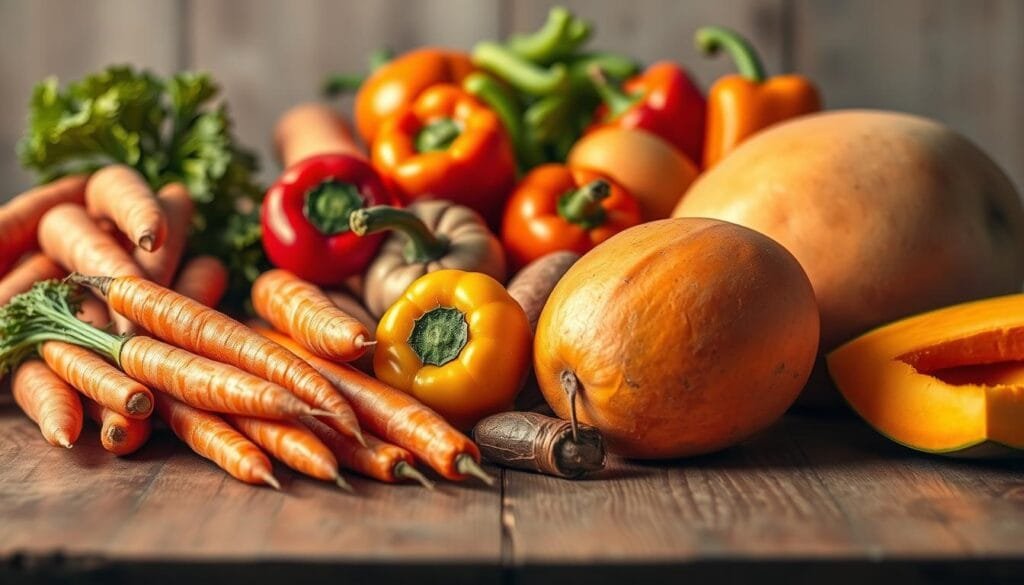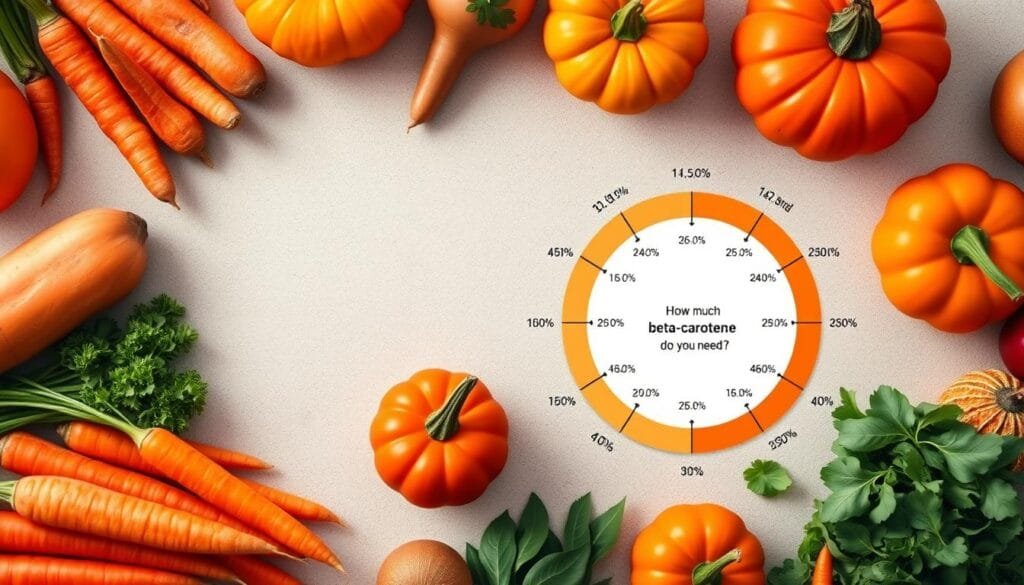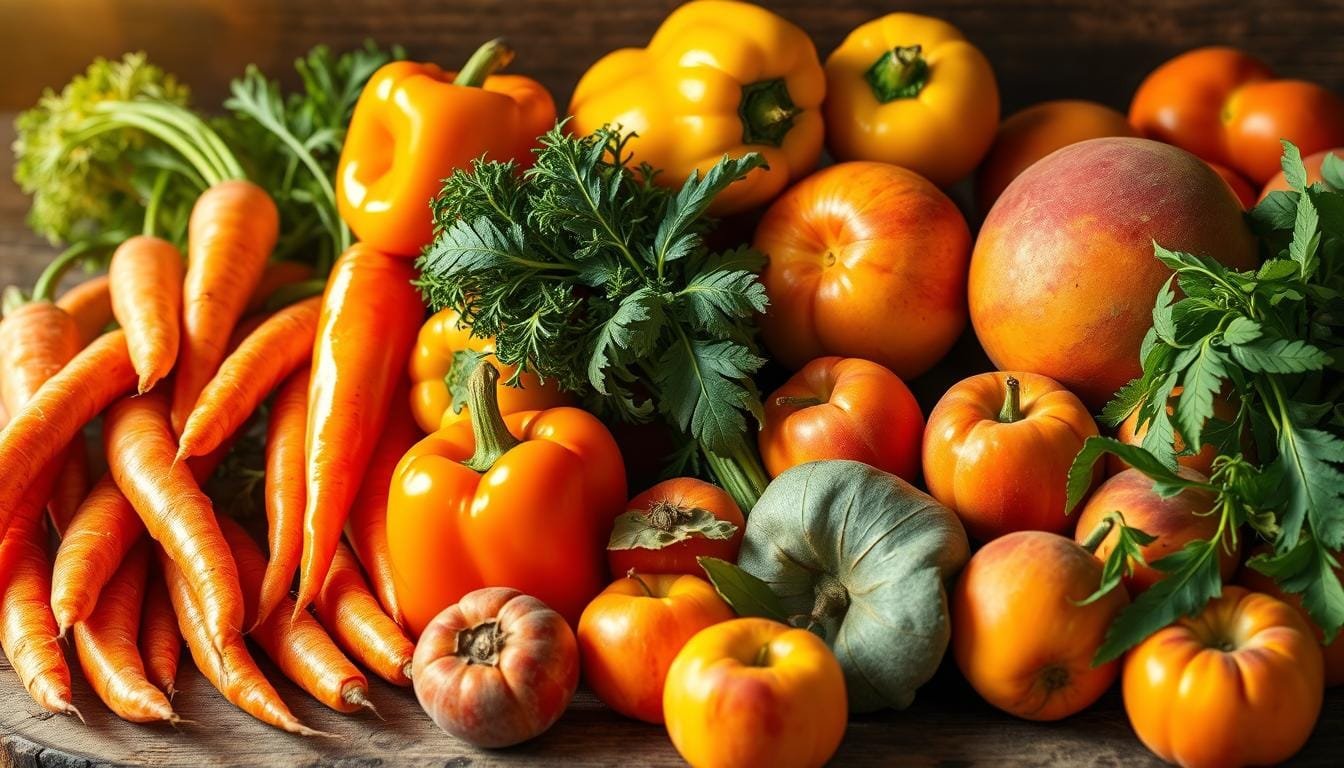Currently Empty: RM0.00
Did you know just one cup of cooked sweet potatoes provides over 400% of your daily vitamin A needs? This powerhouse nutrient comes from beta-carotene, a natural compound that boosts immunity and keeps eyes sharp. Many associate carrots with vision health—thanks to their vibrant hue—but there’s a whole world of colorful options to explore.
Beta-carotene isn’t just about vitamin A. It fights inflammation and acts as a powerful antioxidant, shielding cells from damage. Wellness Concept, a trusted nutrition partner, highlights how these benefits support long-term health. From leafy greens to juicy cantaloupe, nature offers delicious ways to fuel your body.
Key Takeaways
- Beta-carotene converts to vitamin A, essential for immune and eye health.
- It acts as an antioxidant, reducing inflammation and cell damage.
- Sweet potatoes, carrots, and leafy greens are excellent sources.
- Regular intake supports vision and overall wellness.
- Wellness Concept provides science-backed nutrition guidance.
What Is Beta-Carotene and Why Is It Important?
Ever wondered why carrots turn orange or why sweet potatoes glow so brightly? The answer lies in carotenoids, natural pigments that do more than add color—they fuel your health. Among these, beta-carotene stands out as a powerhouse your body converts into essential nutrients.
The Science Behind Beta-Carotene
Carotenoids are a family of compounds found in plants. They act as nature’s sunscreen, protecting leaves and fruits from sun damage. When you eat these plants, your intestines convert beta-carotene into vitamin A, a fat-soluble nutrient critical for vision and immunity.
- Plant vs. Animal Sources: Unlike preformed vitamin A from animal products, beta-carotene is a provitamin—it transforms into active vitamin A as needed.
- Antioxidant Power: It neutralizes free radicals, unstable molecules that harm cells. This reduces oxidative stress, a key factor in aging.
How Your Body Uses Beta-Carotene
After conversion, vitamin A gets stored in the liver and fatty tissues. This storage system lets your body access reserves when dietary intake is low. Water-soluble vitamins, like vitamin C, can’t do this—they exit the body quickly.
Pairing carotenoid-rich foods with healthy fats boosts absorption. Think spinach sautéed in olive oil or carrots with hummus. Your body thrives when these nutrients work together.
Top Foods High in Beta-Carotene
Nature’s brightest hues often signal the richest sources of essential nutrients. These vibrant picks not only add color to meals but also deliver unmatched health benefits. Below, explore the top contenders and their unique advantages.

Sweet Potatoes: A Nutrient Powerhouse
Boasting 9,406 mcg per 100g, boiled sweet potatoes lead the pack. One serving covers 400% of daily vitamin A needs. Their natural sweetness makes them versatile—roasted, mashed, or blended into soups.
“The deep orange flesh of sweet potatoes is nature’s multivitamin, offering fiber and potassium alongside carotenoids.”
Carrots: More Than Just Eye Health
With 8,279 mcg per 100g, cooked carrots shine. Beyond vision support, they contain lutein and zeaxanthin, which protect against blue light damage. Try them raw with hummus or roasted for caramelized flavor.
| Food | Beta-Carotene (mcg/100g) | Key Pairing Tip |
|---|---|---|
| Sweet potato | 9,406 | Drizzle with olive oil |
| Carrots | 8,279 | Serve with Greek yogurt |
| Spinach | 6,103 | Sauté with garlic |
Leafy Greens Like Spinach and Kale
Cooked spinach offers 6,103 mcg per 100g and pairs iron with carotenoids for holistic nutrition. Kale, slightly lower in beta-carotene, compensates with vitamin K. Add them to smoothies or stir-fries.
Bright Fruits: Cantaloupe and Apricots
Half a cup of cantaloupe provides 15% of your daily value. Dried apricots pack a concentrated dose, while fresh ones hydrate. Both make easy snacks or salad toppers.
- Pro Tip: Combine cantaloupe with nuts for fat-enhanced absorption.
- Did You Know? Apricots’ orange hue deepens with ripeness, signaling peak nutrient levels.
Health Benefits of Beta-Carotene-Rich Foods
Vibrant plant pigments do more than brighten meals—they shield your health. These natural compounds transform into vitamin A, fueling critical bodily functions. From defending against infections to preserving sharp eyesight, their benefits are backed by decades of research.
Boosting Immune Function
Vitamin A, derived from carotenoids, acts as a command center for white blood cell production. These cells identify and neutralize pathogens, keeping infections at bay. A study in the Journal of Nutrition found that adequate intake reduces respiratory illness duration by 20%.
Supporting Eye Health and Vision
Retinal tissues rely on vitamin A to process light into clear images. Low levels can lead to night blindness or dry eyes. Research shows a 35% lower risk of age-related macular degeneration (AMD) with consistent carotenoid intake.
- Pro Tip: Lutein and zeaxanthin in leafy greens filter harmful blue light, adding extra protection.
Reducing Inflammation and Oxidative Stress
Chronic inflammation underpins arthritis, heart disease, and even cancer. Carotenoids act like a cleanup crew, neutralizing free radicals before they damage cells. Their anti-inflammatory effects rival NSAIDs, minus the side effects.
| Benefit | Key Mechanism | Food Example |
|---|---|---|
| Immune support | Stimulates white blood cells | Cooked carrots |
| Eye health | Protects retinal tissue | Kale |
| Oxidative stress relief | Scavenges free radicals | Cantaloupe |
“Long-term carotenoid supplementation correlates with slower cognitive decline, per an 18-year NIH study.”
How Much Beta-Carotene Do You Need?
Navigating daily nutrient needs can be tricky—here’s what science says about optimal carotenoid intake. While the body efficiently converts these pigments into vitamin A, understanding recommended amounts prevents imbalances.

Daily Recommendations and Safe Limits
Adults require 700–900 mcg RAE (Retinol Activity Equivalents) daily. One medium sweet potato meets this easily. Preformed vitamin A from animal sources has a stricter upper limit (3,000 mcg), but plant-based carotenoids pose fewer risks.
- RAE Conversions: 12 mcg beta-carotene = 1 mcg RAE. A cup of cooked spinach provides ~540 mcg RAE.
- Supplement Caution: High-dose pills lack the balance of whole foods and may increase lung cancer risk for smokers.
Signs of Deficiency and Overconsumption
Low levels often cause night blindness or dry, flaky skin. Conversely, excessive intake—though rare from foods—can turn skin yellowish (carotenemia). This harmless condition resolves with adjusted intake.
| Condition | Causes | Solution |
|---|---|---|
| Deficiency | Poor diet, fat malabsorption | Add leafy greens, orange veggies |
| Overconsumption | Excess supplements | Stick to food sources |
“Smokers taking isolated beta-carotene supplements showed a 20% higher lung cancer incidence in NIH trials—whole foods remain the safest choice.”
Cooking Tips to Maximize Beta-Carotene Absorption
Unlock the full potential of colorful veggies with smart cooking techniques. How you prepare meals impacts how well your body uses these nutrients. Simple tweaks can boost bioavailability by up to 40%.
Pairing with Healthy Fats
Carotenoids are fat-soluble, meaning they need fats for optimal absorption. Olive oil increases bioavailability by 40% compared to fat-free meals. For high-heat sautéing, avocado oil is a stable choice.
Try raw spinach salads with pumpkin seeds and a drizzle of olive oil. Coconut milk in carrot-ginger soup adds creaminess while enhancing nutrient uptake. These combos make meals tastier and more nutritious.
Best Cooking Methods to Preserve Nutrients
Light steaming retains over 90% of nutrients, unlike boiling, which leaches them into water. Roasting sweet potatoes caramelizes their natural sugars while keeping carotenoids intact.
- Steam lightly: 3–5 minutes for leafy greens to maintain crunch and nutrients.
- Roast smartly: 400°F (200°C) for root veggies to concentrate flavors.
- Avoid prolonged boiling: It strips away water-soluble vitamins and fiber.
“Nutrient loss peaks at 15 minutes of boiling—steaming cuts this by half,” notes a 2023 Journal of Food Science study.
Where to Learn More About Healthy Eating
Taking charge of your nutrition journey starts with trusted guidance. Wellness Concept combines Malaysian dietary expertise with global research to create actionable meal plans. Their approach turns complex science into simple, delicious choices.
Your Partner in Nutrition
As Malaysia’s leading nutrition authority, Wellness Concept offers personalized meal planning tailored to your lifestyle. Their certified dietitians analyze your needs—whether managing dietary restrictions or optimizing energy levels. Clients receive:
- Customized weekly menus featuring locally available ingredients
- Nutrient breakdowns showing vitamin A equivalents per serving
- Smart grocery lists organized by supermarket sections
“Our meal plans convert nutritional theory into fork-ready solutions,” says Wellness Concept’s head dietitian.
Connect With Dietary Experts
Busy schedules shouldn’t block access to professional advice. Wellness Concept provides WhatsApp consultations at +60123822655 for quick dietary queries. Their extended hours accommodate professionals:
| Day | Hours |
|---|---|
| Monday-Friday | 9:30am–6:30pm |
| Weekends | 10am–5pm |
New contacts receive a free recipe eBook packed with carotenoid-rich dishes. From pumpkin lentil curry to mango spinach smoothies, these kitchen-tested ideas make healthy eating effortless.
Conclusion
Fueling your body with nature’s colorful bounty supports lasting wellness. Sweet potatoes, carrots, and leafy greens lead the pack, offering essential nutrients for immunity and sharp vision.
Whole foods outperform supplements, delivering balanced nutrition without risks. Start small—swap processed snacks for roasted carrots or add spinach to smoothies.
For personalized guidance, Wellness Concept’s experts craft easy-to-follow meal plans. Reach them at +60123822655 or explore their recipe eBooks.
Every vibrant bite brings you closer to a healthier future. Your eyes—and body—will thank you.
FAQ
What are the best sources of beta-carotene?
Sweet potatoes, carrots, spinach, kale, cantaloupe, and apricots are excellent choices. These fruits and vegetables are packed with this powerful antioxidant.
How does beta-carotene benefit the body?
It supports immune function, promotes healthy vision, and helps combat oxidative stress. The body converts it into vitamin A, essential for skin and eye health.
Can eating too many beta-carotene-rich foods turn skin orange?
Yes, excessive intake may cause a harmless condition called carotenemia, giving skin a yellowish-orange tint. It’s temporary and resolves with reduced consumption.
Should I take supplements instead of eating whole foods?
Whole foods are preferred because they provide fiber and other nutrients. Supplements may be necessary for deficiencies but consult a healthcare provider first.
What’s the best way to cook vegetables to retain beta-carotene?
Light steaming or roasting with healthy fats like olive oil enhances absorption. Avoid overcooking, which can degrade nutrients.
How much beta-carotene do adults need daily?
While there’s no strict guideline, a balanced diet with colorful fruits and vegetables typically meets needs. Overconsumption from food is rare but monitor supplement use.
Does beta-carotene help prevent age-related eye diseases?
Studies suggest it may lower the risk of macular degeneration. Pairing it with other antioxidants like lutein boosts benefits for vision.
Are there risks to consuming beta-carotene?
High-dose supplements may increase risks for smokers. Stick to natural sources unless advised otherwise by a doctor.



